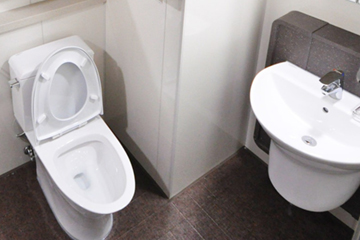
It’s a debate that has been going on for years: should you choose a dual flush toilet or a single flush toilet? They are both very good at doing the job they were made to do and they both have their own set of pros and cons.
So, let’s go over what these are so that you can make an educated decision on which type of toilet to use in your home or business.
The Pros And Cons Of Single Flush Toilets
The most common type of toilet in many homes and businesses is the single-flush. It has one flush mechanism and this means all types of waste are flushed with a similar amount of water and pressure, some times as much as five gallons! It’s no secret that traditional single flush toilets use more water which in turn means you end up paying more in your water bill.
But did you know that the average person flushes their toilet about 17 times per day? It’s a little bit ridiculous, right?! Well, good news! High-efficiency single flush toilets are being rolled out across North America. These new models use 1/2 of what your old model used and they can help save up to 4 gallons of water every time it is flushed. Plus these high efficiency units will last longer than traditional ones too because they don’t suffer as much wear and tear so be sure to check one out when shopping for a replacement.
Also, because single flush toilets are so very common, it’s often easier to find replacement parts for them, which can result in cheaper repair costs. For homeowners who want more control over the aesthetics of their bathroom and toilet, the single flush models allow you to change the look and style whereas the dual flush toilets do not offer that option because there is no lever.
The Pros And Cons Of Dual Flush Toilets
Dual-flush toilets are becoming more popular for households. With two flush mechanisms, one button is used only for liquid waste and the other button is meant to be reserved exclusively for solid waste.
Dual-flush toilets are the best way to save water in your home. They have two buttons located on top of the tank: one button for liquid waste and another for solids. The liquids flush using an average 0.8 gallons while solid wastes use 1,6 gallons which is still a lot less than a regular single flush toilet.
The dual-flush toilet is perfect if you’re looking to conserve some precious H2O around your house or apartment building without sacrificing any functionality – they provide all the features that standard toilets do but only require about half as much volume of water per flush.
A dual flush toilet is great for saving water, but sometimes it takes a little more force to get the button pushed. This can pose problems for elderly people and those with disabilities who have hand or wrist arthritis or weakness.
But by far, the major drawback with dual flush toilets is their cost.
Is A Dual Flush Toilet Worth It?
In terms of water efficiency, a dual flush toilet is the clear winner. With such a system installed in your bathroom, you can save more than 10k gallons per year – an effective way to cut down on your monthly water bills!
If environmental issues are important to you then a dual flush toilet would also be important.
These toilets are growing in popularity in North American. According to Duravit, more than 80% of toilets sold in the North American market are dual flush. – Forbes.com
The decision of whether or not to purchase a single flush or a dual-flush toilet can seem a bit overwhelming. Whether you are remodeling your old bathroom and want it to look more modern with less water usage, or if you are building a new home that is eco-friendly (because we all know this planet needs us as much as possible right now) or if you are renovating the office for comfort reasons, knowing which option will work best for each situation should help make things easier on everyone!
If you have any questions about types of toilets or are having some problems with your toilet, call Atlantis Plumbing today at 770-505-8570. We are available 24 hours a day, 7 days a week.